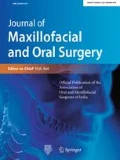Abstract
Purpose
The purpose of this study was to suggest a protocol for the management of odontogenic space infections in patients with hemophilia which is often incompletely addressed by clinicians because of the fear of excessive bleeding leading to prolonged morbidity.
Methods and Results
Six diagnosed cases of hemophilia (four cases of hemophilia A and two cases of hemophilia B) with odontogenic fascial space infection were included in the study. Apart from routine investigations, assessments were also done to identify inhibitors to factor VIII/IX. Factor VIII/IX was replaced along with infusion of factor eight inhibitor bypass activity (FEIBA) one hour before incision and drainage. All the cases were treated by incision and drainage along with removal of foci under local anesthesia. The postoperative outcome was uneventful in all cases except one in which postoperative bleeding was noted from the extraction site on the third day which was again managed following the designed protocol.
Conclusion
Maintaining good oral hygiene and seeking early dental care are of prime importance in patients with hemophilia to avoid invasive procedures. However, if odontogenic infection develops in these patients, performing timely incision and drainage using our protocol will minimize the complications and give successful outcome.

Similar content being viewed by others
References
Patton LL (2003) Bleeding and clotting disorders. In: Burket’s oral medicine: diagnosis and treatment. 10th edn. BC Decker, Hamilton, pp 454–477
Rickard K (1995) Guidelines for therapy and optimal dosages of coagulation factors for treatment of bleeding and surgery in haemophilia. Haemophilia 1(Suppl.l):8–13
Stubbs M, Lloyd J (2001) A protocol for the dental management of von Willebrand’s disease, haemophilia A and haemophilia B. Aust Dent J 46(1):37–40
Lloyd J et al (2000) Guidelines on therapeutic products to treat haemophilia and other hereditary coagulation disorders in Australia. Melbourne, Medical Advisory Panel for HFA (AHCDO)
Sudheesh KM et al (2016) ‘Antihemophilic factor is not the only answer for all factor VIII deficiencies’. Case report of odontogenic infection in a patient with hemophilia A, complicated by factor VIII inhibitors, and managed by transfusion of antihemophilic factor and factor VIII inhibitor bypass activity. Indian J Dent 7(3):149–152
Franchini M (2014) Current management of hemophilia B: recommendations, complications and emerging issues. Expert Rev Hematol 7(5):573–581
Bahl R, Sandhu S, Singh K, Sahai N, Gupta M (2014) Odontogenic infections: microbiology and management. Contemp Clin Dent 5(3):307–311
Rafique S, Fiske J, Palmer G, Daly B (2013) Special care dentistry, 1: dental management of patients with inherited bleeding disorders. Dent Update 40(8):613–616
Farrkh A, Garrison E, Closmann JJ (2016) Dental surgical management of the patient with hemophilia. Gen Dent 64(4):14–17
Nilsson IM (1994) Hemophilia. Pharmacia Plasma Products, Stockholm
Shapiro SS, Huntin M (1975) Acquired inhibitors to the blood coagulation factors. Sem Thromb Hemost 1:336
Sultan Y (1992) The French Hemophilia Study Group. Prevalence of inhibitors in a population of 3435 hemophilia patients in France. Thromb Haemost 67:600–602
Kasper CK (1989) Treatment of factor VIII inhibitors. Prog Hemost Thromb 9:57–86
Lusher JM (1987) Factor VIII inhibitors. Etiology, characterization, natural history, and management. Ann N Y Acad Sci 509:89–102
Nilsson IM, Hedner U, Björlin G (1973) Suppression of factor IX antibody in hemophilia B by factor IX and cyclophosphamide. Ann Intern Med 78:91–95
Nilsson IM, Hedner U (1976) Immunosuppressive treatment in haemophiliacs with inhibitors to factor VIII and factor IX. Scand J Haematol 16:369–382
Brewer A (2008) Dental management of patients with inhibitors to factor VIII or factor IX. World Federation of Haemophilia, Montréal (treatment of haemophilia monograph, no 45)
Author information
Authors and Affiliations
Corresponding author
Ethics declarations
Conflict of interest
The authors declared that they have no conflict of interest.
Informed Consent
Informed consents were obtained from all the patients.
Rights and permissions
About this article
Cite this article
Ansari, M.K., Hashmi, G.s., Ahmed, S.S. et al. Management of Odontogenic Fascial Space Infection in Hemophilia Patients: A Proposed Protocol. J. Maxillofac. Oral Surg. 18, 197–202 (2019). https://doi.org/10.1007/s12663-018-1117-0
Received:
Accepted:
Published:
Issue Date:
DOI: https://doi.org/10.1007/s12663-018-1117-0




